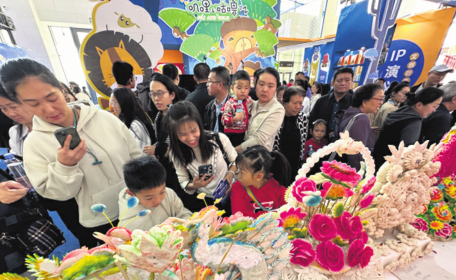

You are here 首页 > ABOUT SHANXI > Cities > Lyuliang > News

Flowery buns, or sculptures made from flour, attract the interest of children and adults during the sixth Shanxi Cultural Industries Fair. [Photo by Li Zhaomin for China Daily]
Biennial event held in Taiyuan to showcase 5,000 years of province's civilization
The abundance of cultural heritage and tourism resources in North China's Shanxi province was showcased at a high-profile event in the provincial capital of Taiyuan last week, once again attracting the attention of tourists and industry insiders throughout the country and in the rest of the world.
The sixth Shanxi Cultural Industries Fair opened on Oct 19 at the Xiaohe International Convention and Exhibition Center in Taiyuan.
With a history of more than 5,000 years, Shanxi is one of the cradles of Chinese culture. The province is one of the national leaders in terms of historical and cultural assets.
The Shanxi Cultural Industries Fair, which was launched in 2013, is a biennial event. Over the past decade, the fair has developed into an important venue to showcase Shanxi's cultural assets, tourism resources and the latest achievements in its cultural industry. It has also witnessed a growing level of globalization, becoming a crucial platform for opening up Shanxi's cultural industry, according to organizers of the event.
This year's event was held both offline and online, building on the success of the fifth session that went online in December 2022 and January 2023.

A replica of Yingxian wooden pagoda is on display. [Photo by Li Zhaomin for China Daily]
The fifth offline fair was originally scheduled to open in 2021. Due to the COVID-19 pandemic, it was postponed and became an online event.
However, with the use of big data, cloud computing, artificial intelligence and virtual reality panorama technologies, organizers said that the "fair on cloud" was a big success, especially when it came to allowing wider participation, enabling visitor interaction, offering immersive experiences and extending the period of exhibition.
Building on the success of previous sessions, this year's fair saw expanded scale and wider participation.
More than 1,000 businesses and cultural entities from China's 26 provincial-level regions, as well as from 12 other countries and regions, displayed more than 100,000 exhibits in an area of about 30,000 square meters.
In addition to the physical shows, the fair was again held online. Organizers said online shows will become a norm of the fair, aimed at creating a "long-lasting event".

Folk musicians from the city of Changzhi play traditional Chinese instruments during the sixth Shanxi Cultural Industries Fair. [Photo by Li Zhaomin for China Daily]
During the event, the host province of Shanxi arranged exhibitions for its various cities.
The city of Shuozhou, for instance, attracted the attention of many visitors by exhibiting its landmark attractions with the help of advanced technologies. A 4.5-meter-high replica of the Yingxian wooden pagoda was the most eye-catching exhibit at the city's pavilion.
The Yingxian wooden pagoda, also known as Sakyamuni Pagoda, is an ancient structure standing some 67 meters high in the Fogong Buddhist Temple in Shuozhou's Yingxian county. Boasting a history of nearly 1,000 years, it is the world's oldest preserved wooden pagoda. In 2016, the Guinness Book of World Records listed it as the tallest wooden pagoda.
To attract attention, the Shuozhou pavilion organizers hired female musicians to play ceramic instruments near the pagoda. Once visitors approached the pagoda, they found they could observe details of the pagoda, even those inside, with the help of virtual reality glasses.
Shuozhou, especially the county of Huairen in its northeast, is renowned for its ceramics industry. Six ceramics producers from Huairen exhibited products at the fair.

Visitors experience the art of wooden block printing at the fair. [Photo by Li Zhaomin for China Daily]
In addition to the exhibition of cultural assets and tourist attractions, the cultural creativity industry was another highlight at the fair.
Shiyuan Cultural Development, a company from Shanxi's Jincheng city, displayed its creative products inspired by the 28 constellations in Chinese mythology.
Products made by the company such as handbags, cups, scarfs and umbrellas featured patents and images of the 28 constellations, legends and legendary figures. In Chinese mythology, each of the constellations is governed by a god.
Ge Qing, a senior executive of Shiyuan, said that the creative products borrowed inspiration from the Jade Emperor Temple in Jincheng.
"The 28 constellation figures are everywhere in the temple," Ge said. "The most prominent are the 28 human-sized statues standing in the western hall in the rear courtyard."
These colored statues were created during the Yuan Dynasty (1271-1368). Researchers said they are representatives of sculptural art in that period.
"Now we are incorporating legends and ancient arts in our product design, aiming to make Shanxi's unique cultural assets better known to people in China and in the world," Ge said. "And these cultural elements also make our products unique and more appealing."
The Shanxi Cultural Industries Fair is also an opportunity for business cooperation.
During this year's event, agreements on 92 key cultural industry projects were signed, which involved a total investment of 23.26 billion yuan ($3.18 billion). These projects covered such sectors as cultural industry parks, performing, digital-empowered creativity, new media and the preservation of cultural relics.
Sun Rui contributed to this story.

Shanxi People's Government Foreign Affairs Office (2014) All rights reserved 晋ICP备09000115号-2
Address:No.366 Yingze Street Taiyuan | Post Code:030001
TEL:+86-351-4034948 Email:service@sxfoa.gov.cn 晋公网安备 14010602060470号